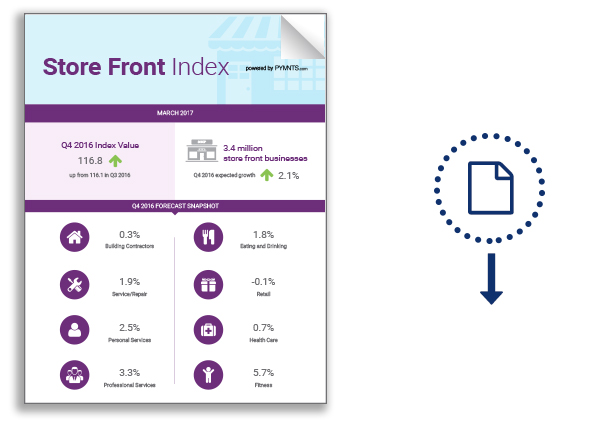Is Main Street USA Winning (Again)?

Main Street USA isn’t just growing — it’s exploding.
The latest PYMNTS Store Front Index™ reveals that store front businesses in the U.S. grew by 2.1 percent in Q4 2016. That growth was powered in part by the booming fitness industry, which clocked in with a 6 percent growth rate, while presumably helping to reduce the collective American waistline at the same time.
The growth comes along with more good news, including improvement in employment rates and overall wages.
While last quarter Building Contractors had the most employment growth, this quarter the Fitness business saw the most growth in employment: a whopping 7.3 percent increase. On the other hand, Eating and Drinking Establishments contributed the most to improvement of wages, with a 5.6 percent growth rate.
Overall, the new Store Front Index™ Score for Q4 2016 was 116.8 points.
Other key takeaways from the index for Q4 2016 include:
- Fitness companies were followed by Building Contractors/Remodelers and Personal Services, both of which grew by 3.9 percent.
- Main Street USA now boasts 3.4 million storefronts, a projected 2.1 percent growth since Q3 2016.
- For a second quarter in a row, Mountain and Southern states continued to grow at the fastest rate. The two regions grew by 3.9 percent and 3.6 percent, respectively, in Q2 2016.
The Q1 2017 edition of Store Front Index™ also includes an interview with Cayla Marvil, cofounder of Lamplighter Brewing Co., who talked about the challenges that curb the process of setting up shop, the lessons learned along the way and the rewards of being a bustling neighborhood brewery.
To download the analysis, please click below…
About the Index
The PYMNTS Store Front Index™ provides a quarter-by-quarter indexing of the health of a subset of small businesses in the United States.
Specifically, the index focuses on “storefronts,” or the shops that line the main and side streets of our local communities.
To compile the index, we used data from the Quarterly Census of Employment and Wages provided by the U.S. Bureau of Labor Statistics.
All told, more than 10 million data records covering the number of establishments, employees and total wages are used to developed the index. The index is calculated as a weighted average of three factors: number of locations, number of employees and total wages paid for select industries.

